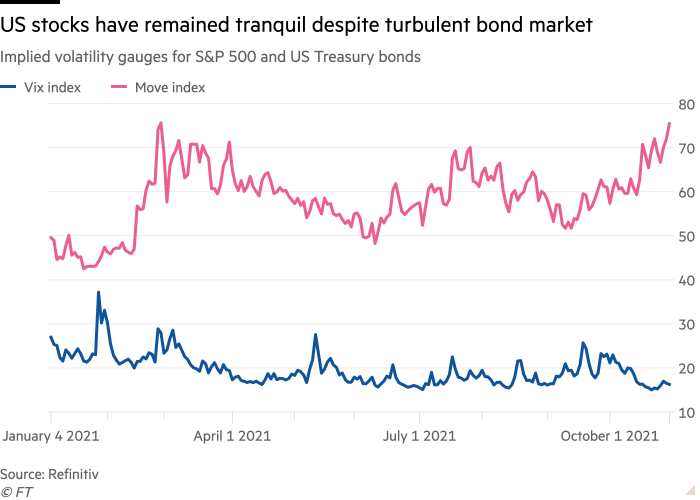US bond tumult risks triggering stock market volatility, analysts warn

Roula Khalaf, Editor of the FT, selects her favourite stories in this weekly newsletter.
Volatility in US bonds is surging in stark contrast to the relatively placid run for equities, leading some analysts to warn over the danger that central banks trigger a spasm of volatility in Wall Street’s stock market.
Fixed income markets have been jolted by fears that rising inflation will force monetary policymakers into scaling back stimulus programmes, but stocks have largely shrugged off these concerns, with Wall Street’s main equities barometers rallying to a series of new record peaks last week.
The gap between measures of the near-term, derivatives-implied volatility of the S&P 500 benchmark and US Treasury bonds has widened at its fastest rate in a decade, according to Bank of America. Some analysts now warn that the divergence indicates investors are complacent about the risks posed by more hawkish central banks.
“Equities — and equity volatility — should not miss the forest for the trees, as they’ve never been more dependent on the Fed and the Fed has never been more dependent on economic data, which itself has never been more volatile,” Riddhi Prasad, a Bank of America analyst, said last week.
The divide in the Vix index of stock volatility and the Move gauge tracking fixed income has been driven by the disparate performance of the two asset classes over the past month. Strong corporate earnings lifted US equities by almost 7 per cent in October in the best month this year, pushing the Vix to a post-coronavirus crisis low of 15.
However, government bonds have been rumbled by signs that quickening inflation will force central banks to tighten monetary policy sooner than Wall Street had previously expected.

Prasad said that the volatility of inflation itself remained at highs last seen in the 1970s, and argued that officials at the US Federal Reserve “have never been more uncertain on their own outlook” on policy. This was “a precarious backdrop for such a self-confident equity market”, Prasad noted.
Christian Mueller-Glissmann, a strategist at Goldman Sachs, also noted the widening schism, and warned clients last week that “the risk of a ‘balanced bear’ — that is, of a combined equity and bond sell-off — lingers as growth decelerates further and inflation remains sticky”.
Technical reasons can explain how stocks can remain relatively subdued in spite of turbulent fixed income markets, such as the unwinding of leveraged hedge fund positions in the latter — which some analysts and investors say has happened in recent days, added Peter Tchir of Academy Securities.
Nonetheless, he also expressed concerns that the stock market was mistakenly oblivious to the volatility that has struck bond markets, and highlighted riskier slices of the corporate debt market as also vulnerable to a setback.
“I just cannot shake the idea that the confluence of events is leading to an ugly day or two of serious ‘risk-off’, which will hit equities and even credit, though high yield and leveraged loans would bear the brunt of that move,” he said.
Jack Caffrey, a portfolio manager at JPMorgan Asset Management, agreed that fixed income markets “do have a finer risk antenna” than equities, and that the recent volatility could presage wider tumult. But he pointed out that equities still enjoyed a supportive backdrop.
“Most companies are pointing to very robust demand environments. The future still seems pretty bright — there are challenges, but they are perceived to be shorter term,” he said. “Right now companies are profitable . . . [and] rising cash returns make it easier to look through rising rates.”
Comments